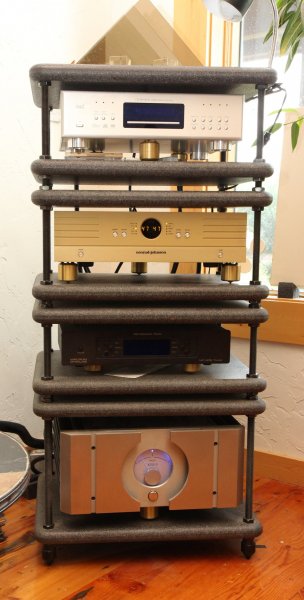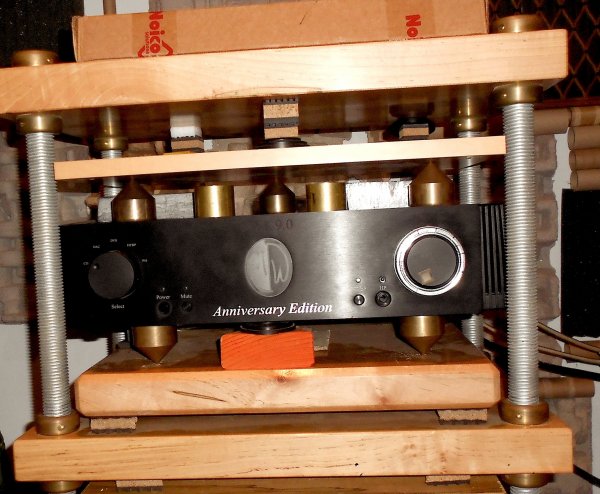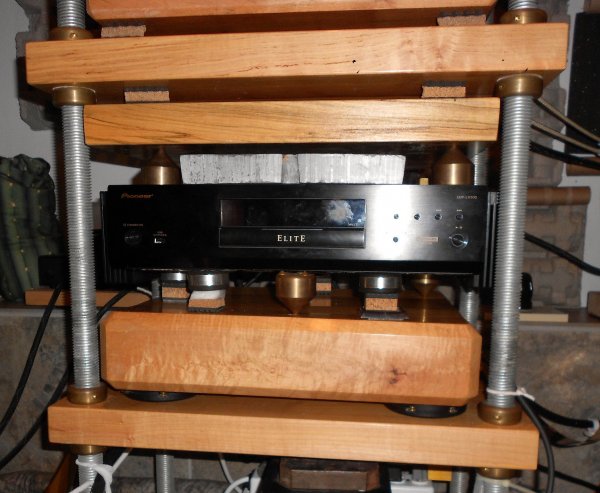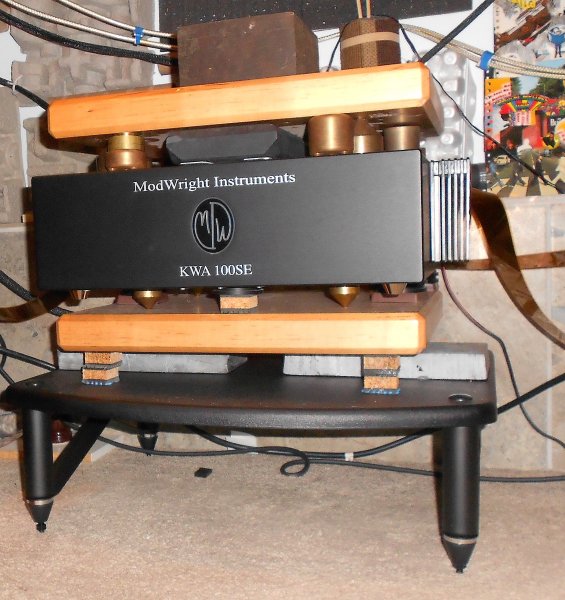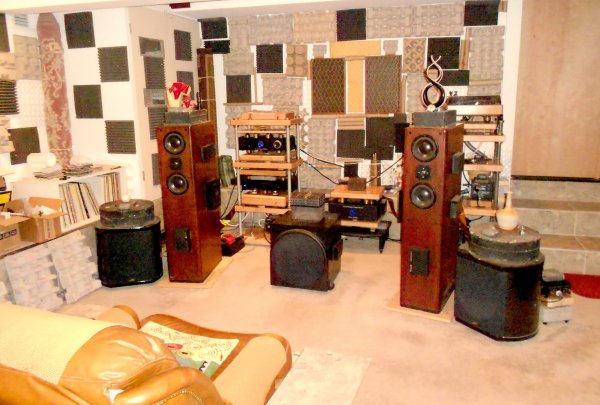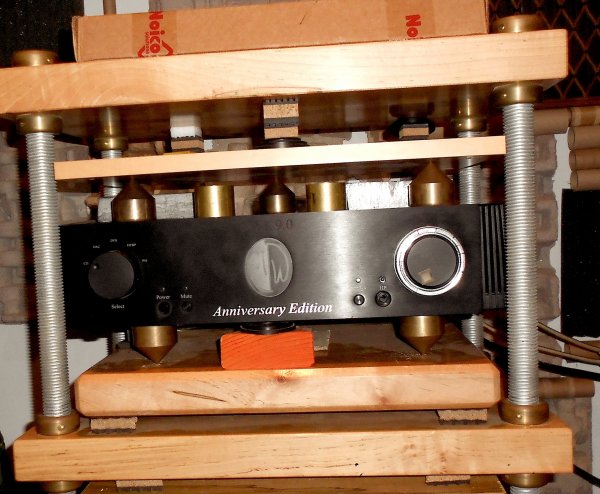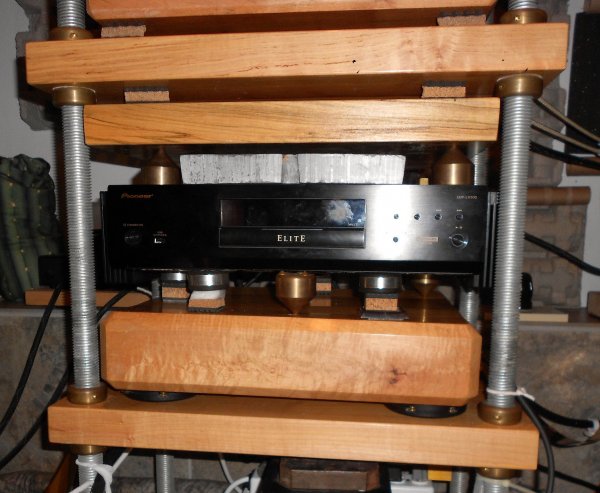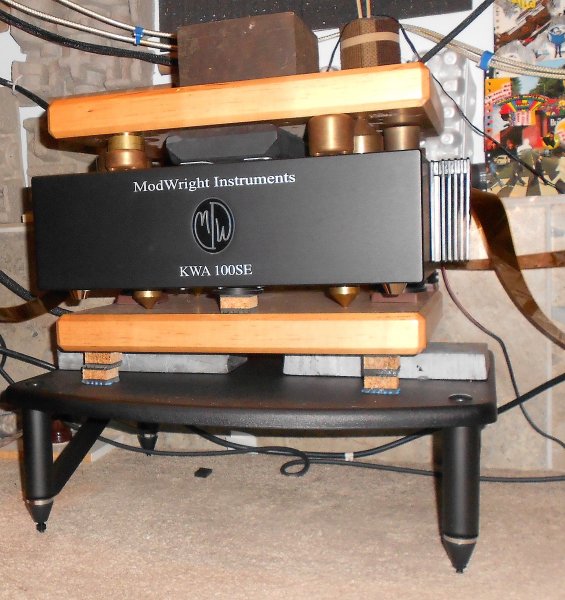The concepts of mass loading and internal damping of stereo gear are often overlooked and underappreciated.
First, massive shelving units should be utilized.
I use the Mapleshade Samson Racks. They are TANKS!
These racks are spiked through a thick carpet into the cement floor
FTR, I use 100% ModWright products.
All my components and speakers have heavy weights placed on top of them (usually Lead and Brass).
The total weight ranges from 25-50 lbs.
I use brass cones underneath to prevent lateral shifting.
These cones interface with 2-4” Maple Plinths which are further isolated from the actual Maple Shelves by using dampening devices. Also utilize some Sorbothane footers to further dampen self generated component vibrations.
In addition, my CD Player and Pre Amp have inverted cones on the top of the chassis. I tighten my adjustable shelving which sandwich and squeeze the components between shelves.
The component does not move in any direction. Period!
My Amp uses a floor plinth arrangement with heavy weights on top.
The next step is to deaden the chassis and internal components to the maximum extent possible. I use Noico 80 mil Car Sound Deadening Material on the unit’s internal sides, bottom and top, in multiple sheets where it is feasible. I also dampened any component or part which would accept a treatment. Transformers and CD Drives for instance.
Added silicon rings and brass hexnut “crowns” to my small signal tubes.
So far I’ve treated my Amp and CD player.
Will do the Pre Amp in the near future.
Finally, I placed a dab of RTV on the top of every capacitor I could reach. Caps are probably the most sensitive component to vibration.
A lot of people seem to think mass loading and component damping can take the life out of the music.
My experience has shown that this is not the case.
The above tweaks have GREATLY elevated the sound quality, imaging and soundstage in my system.
The bass is super tight, articulated and thunderous.
I actually had to reduce the volume of my subwoofers.
All this was especially evident after I treated the CD Player.
This is the logical place to start such treatments.
Admittedly, quite a bit of manhours are required to undertake this project. But the rewards are WELL worth it!
First, massive shelving units should be utilized.
I use the Mapleshade Samson Racks. They are TANKS!
These racks are spiked through a thick carpet into the cement floor
FTR, I use 100% ModWright products.
All my components and speakers have heavy weights placed on top of them (usually Lead and Brass).
The total weight ranges from 25-50 lbs.
I use brass cones underneath to prevent lateral shifting.
These cones interface with 2-4” Maple Plinths which are further isolated from the actual Maple Shelves by using dampening devices. Also utilize some Sorbothane footers to further dampen self generated component vibrations.
In addition, my CD Player and Pre Amp have inverted cones on the top of the chassis. I tighten my adjustable shelving which sandwich and squeeze the components between shelves.
The component does not move in any direction. Period!
My Amp uses a floor plinth arrangement with heavy weights on top.
The next step is to deaden the chassis and internal components to the maximum extent possible. I use Noico 80 mil Car Sound Deadening Material on the unit’s internal sides, bottom and top, in multiple sheets where it is feasible. I also dampened any component or part which would accept a treatment. Transformers and CD Drives for instance.
Added silicon rings and brass hexnut “crowns” to my small signal tubes.
So far I’ve treated my Amp and CD player.
Will do the Pre Amp in the near future.
Finally, I placed a dab of RTV on the top of every capacitor I could reach. Caps are probably the most sensitive component to vibration.
A lot of people seem to think mass loading and component damping can take the life out of the music.
My experience has shown that this is not the case.
The above tweaks have GREATLY elevated the sound quality, imaging and soundstage in my system.
The bass is super tight, articulated and thunderous.
I actually had to reduce the volume of my subwoofers.
All this was especially evident after I treated the CD Player.
This is the logical place to start such treatments.
Admittedly, quite a bit of manhours are required to undertake this project. But the rewards are WELL worth it!







